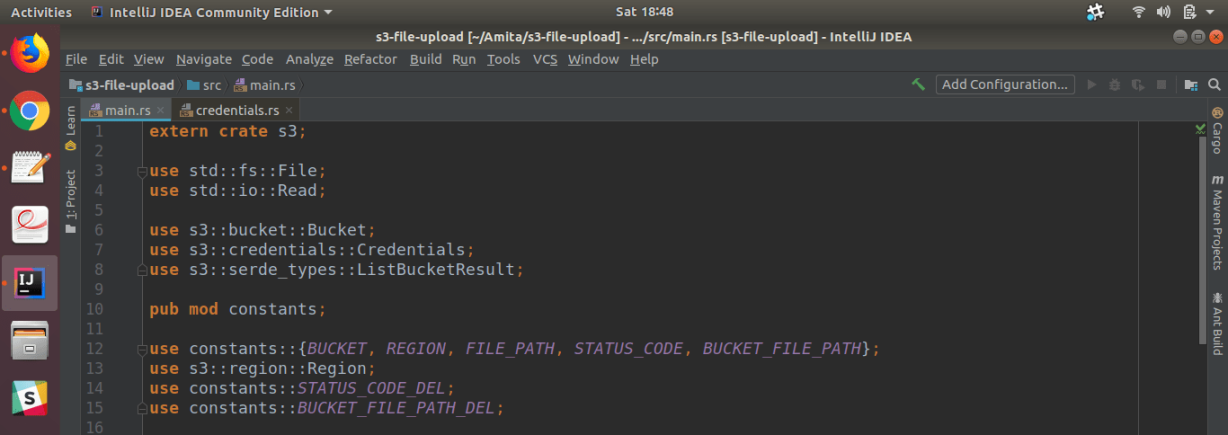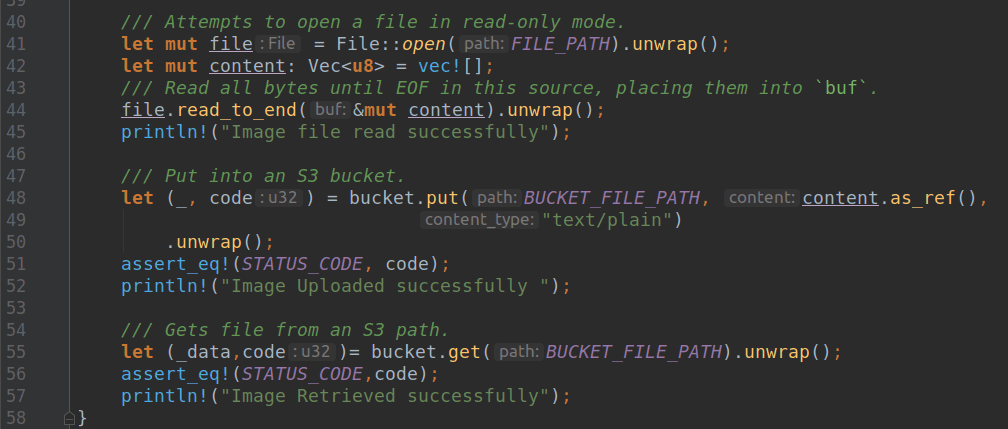Welcome everyone to the file upload on Amazon S3 using the Rust.
Amazon S3 [Amazon Simple Storage Service] provides virtually limitless storage on the internet. For the bucket creations and security credentials please refer to my last blog. This blog explains following requests using Rust:
- sending a request to aws S3 bucket,
- list of objects in the bucket,
- putting an object in the bucket,
- deleting an object from the bucket, and
- getting an object from the bucket.
Let’s take a simple example of an image file:

In Fig.1, line no. 10 “pub mod constants” is used to create a new module named by constants to externalize all the paths and magic number and line no.12,14,15 for importing all the constants.

In Fig.2, we have created several constants for bucket’s name [line no.1], region’s name [line no.2], the path of a local file to be uploaded [line no.3], the path of a bucket where local file is to be upload [line no.6], etc in constants.rs module/file.

We can get credentials in three ways:

AWS access credentials: access key, secret key, and an optional token.
1. Loads credentials directly

2. Loads credentials from the environment

3. Loads credentials from the profile
3.1 Loads credentials from [default] profile
let credentials: Credentials = Credentials::new(None, None, None, None);
or
let credentials: Credentials = Credentials::default();
3.2 Loads credentials from [“my-profile”] profile
let credentials: Credentials = Credentials::new(None, None, None, Some("my-profile".into()));

In Fig.7, you can see that Bucket::new() is used to instantiate a new Bucket. bucket.list lists all the contents of an S3 bucket and bucket.delete deletes file from an S3 path. All requests on S3 bucket returns a tuple (data, code) where the code is of u32 type, represents the status code for that particular request.
assert_eq!(STATUS_CODE, code); tests the particular request by matching left value to the right value.

In Fig.8, File::open(..) is used to open a file in reading mode only then read_to_end() reads the content of a file to the end and stored in a vector content .
put() method is used to put the content in the bucket and get() method is used to retrieve the file from S3 bucket.
If you will merge the code of Fig.1, 2, 3, 7, 8, you will get full code for all types of request to S3 bucket.
Output by adding the dependency rust-s3 = “0.11.0” in cargo.toml file and executing the code cargo run :

And you can now check your S3 bucket, it will have the file which you have put in it. This code can work for any type of file extensions.
I hope this blog helps you in some way, comment in the inbox for any type of query.




Consider using Dia (https://wiki.gnome.org/Apps/Dia) to draw your diagrams, it can make making nice looking (lines connecting properly) diagrams much easier.
Have fun using Rust!
Thanks for suggestion. I”ll refer to it.